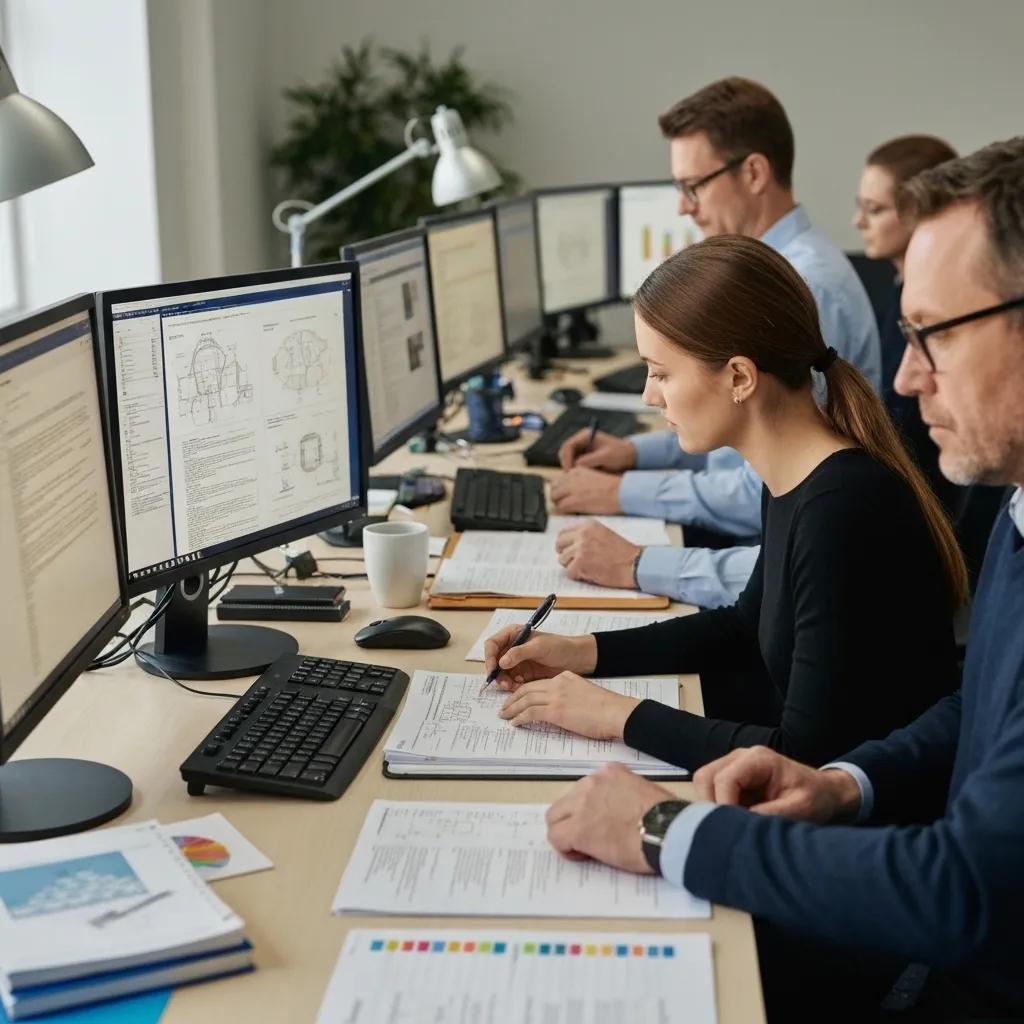Unlock Global Markets: Expert Technical Translation for Your Complex Manuals

Navigating the Nuances: Why Expert Technical Translation is Key
Technical language can be a significant hurdle for international audiences, potentially leading to safety concerns, compliance issues, and missed business opportunities. Professional technical translation services bridge this gap by transforming specialized terminology into clear, accurate content tailored for each culture and language.
This guide will delve into:
- The inherent complexities and potential pitfalls of technical language
- The critical role of specialized translation in ensuring precision, compliance, and effective localization
- The essential elements of professional technical translation processes
- How meticulously translated manuals become powerful global assets
- Common challenges encountered when translating intricate documentation
- Strategic semantic SEO techniques to elevate the visibility of translation services
- Emerging trends poised to shape the future of expert technical translation
By integrating AI-driven approaches for technical writing and leveraging deep subject matter expertise, this article provides a comprehensive roadmap for converting dense technical content into universally accessible global assets.
Understanding Technical Jargon: The Translation Challenge
Technical jargon comprises field-specific vocabulary where precision is paramount for correct product operation. Its complexity stems from dense acronyms, evolving industry standards, and unique terminology that may lack direct equivalents in other languages. For instance, instructions for medical devices often contain terms with significant regulatory implications, making any misinterpretation a serious safety risk. Recognizing these defining characteristics highlights why only trained linguists with specialized domain knowledge can accurately convey intent and function across diverse cultures.
What Characterizes Technical Language?
Technical language is defined by highly specialized terms, acronyms, and structured syntax intended for expert audiences. It prioritizes accuracy over stylistic flair and typically includes:
- Standardized acronyms (e.g., API, CAD)
- Industry-specific neologisms (e.g., quantum entanglement)
- Structured numbering or sequential instructions
- Embedded references to regulations or technical specifications
Each of these elements demands precise mapping into target languages to preserve original function and intent. An incorrectly translated acronym or numerical reference can disrupt an entire procedure, underscoring the necessity for expert translation to begin with thorough term analysis and context validation, ensuring manuals retain their original effectiveness and safety standards.
Which Industry Terms Pose the Greatest Translation Difficulties?
- Regulatory Standards: Compliance codes like ISO certifications and FDA classifications require exact, legally recognized equivalents.
- Engineering Abbreviations: Acronyms such as “SCADA” (Supervisory Control and Data Acquisition) may not have direct counterparts in all languages.
- Software Interface Elements: User interface labels and API function names often need a careful balance between literal accuracy and user-friendliness in the target locale.
- Medical Terminology: Manuals for medical equipment frequently include pharmacological or anatomical terms subject to stringent compliance requirements.
Overcoming these challenges necessitates a combination of comprehensive glossary development, close collaboration with subject matter experts, and rigorous validation processes to guarantee consistency across all document versions.
How Do Cultural Nuances Impact the Understanding of Technical Jargon?

Technical content is inherently influenced by cultural contexts that affect readability and acceptance. For example, safety warnings must conform to local conventions regarding color, tone, and phrasing; what conveys urgency in one market might seem overly alarming in another. Adapting metaphors, measurement systems, and visual aids to local norms is crucial to prevent confusion. Recognizing cultural nuances early in the translation process ensures that manuals are not only linguistically correct but also culturally resonant and compliant with regional expectations, paving the way for smooth product adoption.
The Indispensable Value of Expert Technical Translation Services
Expert technical translation services integrate specialized domain knowledge, stringent quality assurance protocols, and cultural adaptation to produce manuals that function reliably across the globe. Without these services, companies risk misinterpretations that can lead to product malfunctions, costly non-compliance penalties, and damage to their reputation. Professional linguists effectively bridge language divides and embed regulatory and cultural requirements into every sentence, ensuring that manuals perform as intended in each target market.
Ensuring Accuracy and Precision in Technical Documents

Expert translators employ a systematic validation approach:
- Terminology Research: They meticulously build and maintain glossaries featuring industry-recognized terms.
- Parallel Review: Multiple linguists cross-reference each segment against the source material for verification.
- Quality Assurance: Automated QA tools meticulously check for errors in numerical data, formatting, and consistency.
This multi-faceted process guarantees that every technical phrase is translated with the same level of accuracy as the original, thereby preventing user errors and safeguarding product integrity.
The Critical Role of Regulatory Compliance in Technical Translation
Regulatory compliance mandates that manuals adhere to local legal standards for safety, labeling, and operational instructions. For instance, an electrical equipment manual intended for distribution within the EU must reference relevant CE directives and harmonized standards in the local language. Expert translation services integrate compliance checks into their workflow, aligning content with regulations such as ISO 17100, UL standards, or specific local certification requirements, which helps to expedite approval processes and mitigate legal liabilities.
Bridging Gaps Through Localization
Localization goes beyond mere translation by adapting elements such as measurements, date formats, visuals, and idiomatic expressions to suit the target culture.
- Converting imperial units to metric equivalents
- Revising diagrams to accommodate different reading directions
- Replacing colloquialisms with locally relevant metaphors or examples
These adaptations ensure that translated manuals feel authentic, maximize user comprehension, and enhance brand perception across diverse markets.
The Pillars of Professional Technical Translation Services
Professional technical translation harmonizes human expertise with cutting-edge technology to deliver documentation that is both consistent and of the highest quality. The foundational components include skilled linguists, robust terminology management systems, translation memory tools, and AI-enhanced workflows designed to expedite delivery without compromising accuracy.
Why Subject Matter Expertise is Non-Negotiable
Subject matter experts (SMEs) bring invaluable industry-specific knowledge that general translators may lack. An SME-involved translation process:
- Identifies subtle distinctions in technical specifications
- Validates the accuracy of specialized diagrams and schematics
- Resolves ambiguous source text phrases based on practical experience
This deep expertise eliminates guesswork, ensuring that complex concepts are conveyed with precision and clarity.
The Synergy of AI and Human Expertise in Post-Editing
Machine translation (MT) provides rapid initial drafts, but post-editing by expert linguists is essential for ensuring accuracy and maintaining the appropriate tone. A typical hybrid workflow involves:
- An MT engine generates a preliminary draft for large volumes of content.
- A human linguist meticulously edits the draft for technical correctness, compliance, and stylistic nuances.
- A final quality assurance (QA) review confirms regulatory adherence and stylistic consistency.
This integrated approach leverages AI for efficiency while retaining crucial human oversight for precision, enabling scalable project execution without compromising quality.
Transforming Manuals into Strategic Global Assets
Expanding Market Reach Through Accurate Translation
Translated manuals are the gateway to new international markets, removing linguistic barriers to product adoption. Companies often experience up to a 25% acceleration in market entry when their manuals meet local language preferences and regulatory standards. This direct correlation between manual clarity and successful product penetration highlights the strategic importance of investing in expert translation services.
Elevating User Experience and Brand Reputation
Clear, culturally adapted documentation:
- Can reduce customer support inquiries by as much as 40%.
- Leads to higher end-user satisfaction ratings.
- Strengthens brand perception as being customer-centric and reliable.
When users find instructions intuitive and easy to follow, they develop greater trust in the brand and are more inclined to recommend its products, fostering a positive cycle of enhanced reputation and increased sales.
Mitigating Legal and Safety Risks
Accurate manuals significantly reduce the potential for misinterpreting critical safety warnings and operational procedures. Properly translated safety instructions are vital for preventing equipment misuse and averting workplace accidents. Organizations that prioritize rigorous translation practices typically observe a notable decrease in liability claims and regulatory citations, thereby protecting both their users and their corporate interests.
Confronting the Challenges of Complex Technical Manual Translation
Translators encounter numerous obstacles, from obscure terminology to intricate document layouts, all of which necessitate specialized workflows for effective resolution. Identifying and addressing these challenges is fundamental to delivering manuals that function seamlessly across different cultures and platforms.
Overcoming Specialized Terminology Gaps
Bridging terminology gaps begins with a collaborative glossary creation process:
- Compile existing term lists from the source language.
- Engage SMEs to confirm precise definitions.
- Validate target language equivalents with native-speaking engineers or specialists.
This meticulous approach ensures that every critical term has an approved translation, eliminating ambiguity and promoting consistent usage throughout all documentation.
Maintaining Context and Consistency in Intricate Documents
Preserving context and consistency involves several key steps:
- Segmentation: Breaking down documents into logically coherent units.
- Contextual Markups: Embedding explanatory notes for diagrams, tables, and code snippets.
- Concordance Checking: Utilizing translation memory tools to cross-reference recurring segments and ensure uniformity.
These measures maintain the logical flow and technical coherence of extensive manuals, even when multiple translators contribute to a single project.
The Criticality of Cultural Adaptation and Localization
Cultural adaptation extends beyond language to encompass the entire presentation of content:
- Colors, icons, and symbols may carry different connotations in various cultures.
- Metaphors or analogies used must resonate with local audiences.
- Legal disclaimers require region-specific phrasing to be effective.
Failure to adapt these elements can render an otherwise accurate translation ineffective, undermining user safety and overall satisfaction.
Managing Complex Document Structures
Expert services integrate desktop publishing (DTP) specialists and localization engineers who are adept at:
- Extracting text from images and CAD diagrams for translation.
- Localizing code comments without compromising functionality.
- Reconstructing document layouts to preserve original formatting.
This specialized handling ensures that every element, whether textual or visual, remains intact and functional post-translation, contributing to a seamless user experience.
Leveraging Semantic SEO for Enhanced Visibility
Optimizing with Structured Data Markup
While schema.org markup is not directly visible, implementing best practices includes:
- Utilizing the Service schema for core offerings.
- Applying the Tech Article schema for educational content.
- Employing the FAQ Page schema for frequently asked questions related to translation.
Implementing these markups behind the scenes improves eligibility for rich search results without altering the user-facing content.
Boosting Search Engine Understanding with FAQs and Glossaries
Integrating FAQs and a dedicated glossary featuring Defined Term entries:
- Signals' expertise in defining technical jargon.
- Increases the likelihood of appearing in “People Also Ask” sections and term-definition snippets.
- Reinforces topic clusters relevant to translation services.
These elements enrich the semantic context of your content and create multiple organic search entry points.
Best Practices for Internal Linking and Entity-Rich Anchor Text
Anchor text should strategically pair entities with relevant actions or attributes, for example:
- “streamlined technical translation workflow”
- “navigating regulatory compliance in user manuals”
Limit links to one per section and integrate them naturally within explanatory sentences to maximize relevance and PageRank flow.
The Horizon of Technical Translation: Future Trends
The Impact of AI and Generative AI
Generative AI models are now capable of producing context-aware translation suggestions that:
- Accelerate the creation of first drafts for extensive manuals.
- Automatically identify and flag inconsistent terminology.
- Propose culturally adapted phrasing tailored to specific target audiences.
Human experts then refine these AI-generated outputs, achieving high productivity without compromising linguistic precision.
Emerging Technologies for Enhanced Efficiency and Quality
Innovations poised to drive future advancements include:
- Neural Machine Translation (NMT) Engines: Enhanced with domain-specific training for greater accuracy.
- Augmented Reality (AR): Enabling on-device translated documentation overlays.
- Blockchain-backed Term bases: Securing and facilitating the sharing of approved glossaries.
These technologies promise faster turnaround times, richer user experiences, and unwavering terminological consistency.
Anticipating Regulatory Shifts and Their Impact
Evolving regulations, such as updates to ISO 17100 or new regional directives, will necessitate:
- More frequent content audits and reviews.
- Dynamic update capabilities within translation memory systems.
- Automated checkpoints for compliance validation.
Staying ahead of these regulatory changes ensures that translated manuals remain legally sound and market-ready as standards evolve.
Expert technical translation services transform opaque terminology into clear, compliant, and culturally attuned manuals that serve as genuine global assets. By integrating subject matter expertise, advanced technology, and strategic semantic SEO, organizations can unlock new markets, foster user trust, and effectively mitigate legal and safety risks. As AI and emerging technologies continue to reshape workflows, partnering with a specialized provider becomes essential for converting complex documentation into strategic, worldwide resources.








